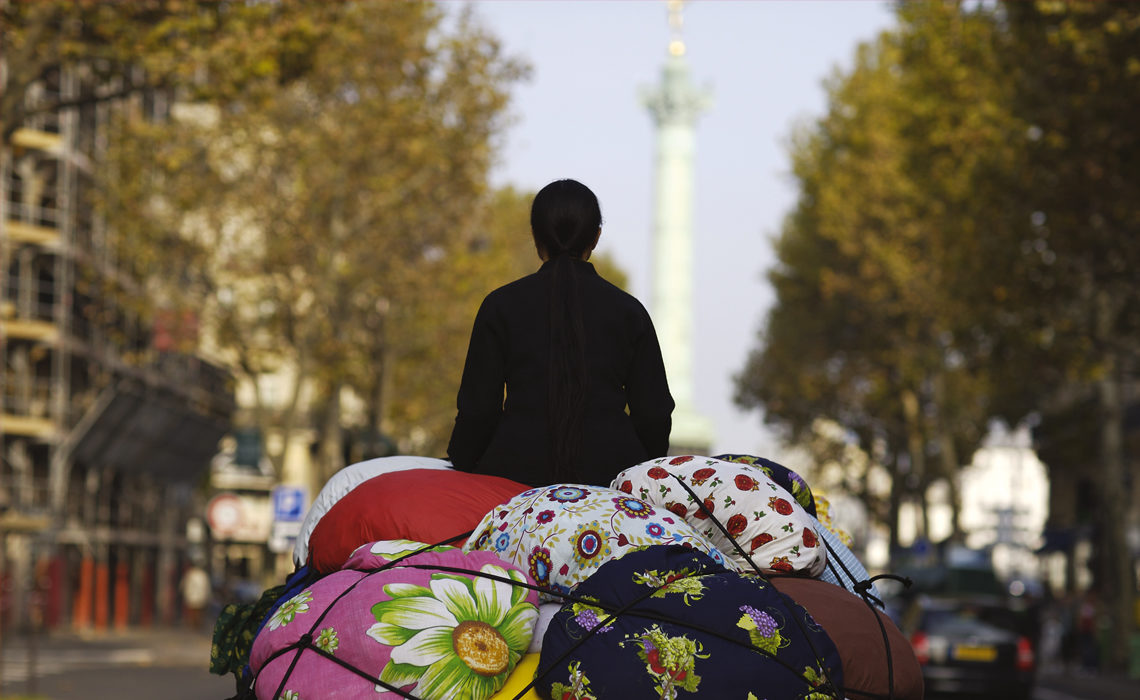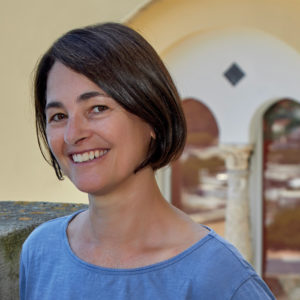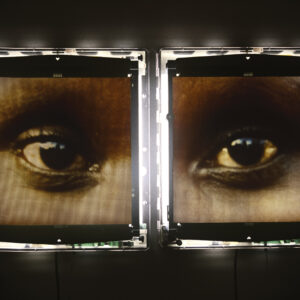Nella cultura coreana, “obangsaek” è il nome con cui si identifica lo spettro dei colori principali: rosso, nero, blu, bianco, giallo. Partendo da questo modello a cinque principi, si definiscono, rispettivamente, le direzioni, sud, nord, est, ovest e centro. E poi gli elementi: fuoco, acqua, legno, metallo o oro e terra. E quindi i simboli e, di conseguenza, i comportamenti e le abitudini a essi riferiti. Per esempio, il rosso, il colore del sud e del fuoco, allontana gli spiriti maligni. Per questo, in Corea si osserva la tradizione di mangiare una zuppa di fagioli rossi nel giorno del solstizio d’inverno. Corde d’oro, il colore del sole, della terra e del centro, sono usate per contrassegnare luoghi santi e che hanno bisogno di protezione, come la casa in cui una madre ha appena dato alla luce un bambino. Alternando le gradazioni dell’obangsaek vengono confezionati gli hanbok, gli abiti tradizionali usati per le cerimonie formali, e si prepara il bibimbap, un misto di riso, verdure, manzo e pollo. L’infinita varietà dell’universo, dagli aspetti minuti della vita quotidiana, al misterioso rapporto con le dimensioni più distanti, risponde alla successione dei cinque colori. Ed è da questa sintesi estrema che si sviluppa l’arte di Kimsooja, consacrata alla ricerca della forma dell’armonia, nel caotico spazio del cosmo, a partire dalla condizione dell’individuo.
Potenti e silenziose, contemplative ed esuberanti, in perfetto equilibrio tra il pieno e il vuoto, tra la presenza e l’assenza, libere dai vincoli della cronaca e dell’episodio ma spesso riferite ai movimenti della storia e dell’attualità, le opere dell’artista coreana derivano dall’applicazione dell’obangsaek ai linguaggi della scultura, dell’installazione ambientale, della performance, del video, dell’architettura, della tessitura. Materiali e tecniche che Kimsooja attraversa con consapevolezza e senza soluzione di continuità, come un unico medium dilatato e ibrido, tra contemporaneità e tradizione.
Dopo aver studiato pittura occidentale alla Hongik University di Seul – l’influsso delle teorie di John Cage e Lucio Fontana sullo spazio e sulla percezione sarebbe stato poi decisivo nella sua indagine – Kimsooja trascorse un fecondo periodo a New York. Qui, tra il 1992 e il 1993, ebbe modo di partecipare a un progetto di residenza curato dal MoMA PS1, confluito poi in una collettiva, “In Their Own Image:
the 1992 – 1993 Studio Artists Exhibition”. In quella occasione presentò Bottari, opera che, ancora adesso, rimane tra le più rappresentative della sua ricerca. In Corea, i Bottari sono i copriletto matrimoniali che si regalano agli sposi, come segno beneaugurante per la loro nuova vita. Ricamati con cura e dedizione, i Bottari si intrecciano a mo’ di grande fagotto, per custodire, a loro volta, altri tessuti e indumenti. Per il suo progetto al MoMA PS1, Kimsooja recuperò questo oggetto già densamente simbolico, per estenderne e, allo stesso tempo, sovvertirne, la definizione.
Vibranti ed enigmatici, traslati in un contesto di alterità come quello di un museo, i Bottari non solo si fanno portavoce di una specifica condizione femminile, ma assurgono anche a icone esistenziali dello spostamento, della migrazione, del cambiamento del proprio stato – o della propria stasi – per volontà, necessità o costrizione. Un ribaltamento di genere, rispetto all’immaginario del viaggio stratificatosi nella cultura occidentale, sostanzialmente riferito a stereotipi maschili. «Anche se ho lavorato molto usando la femminilità e le attività femminili, non mi sono mai considerata una femminista. La mia intenzione è di raggiungere, nell’arte, la totalità della vita», precisava la stessa Kimsooja, in un’intervista del 2013. D’altra parte, non può esserci separatezza nell’atto del cucire, una pratica che, disponendo il pensiero alla contemplazione e attivando una gestualità minimale, stabilisce la simmetria tra gli elementi, l’equilibrio tra le varie parti della stessa struttura.
«Senza un ago, non ci sarebbe tessuto, e senza ogni individuo non ci sarebbe società», spiega l’artista, nata nel 1957 a Daegu, città che, tra gli anni ’60 e gli ’80, era il motore economico trainante della Corea del Sud, principalmente per l’elettronica e anche per la coltivazione di mele rosse di alta qualità, il cui primo albero, si dice, fu piantato nel 1899 da un missionario. Ma Daegu è storicamente conosciuta soprattutto per i suoi tessuti, le cui tecniche di filatura sono state tramandate da generazione a generazione, passando dall’artigianato – che comunque resiste ancora – alla produzione industriale, dalla dimensione intima e famigliare, agli scaffali dei negozi, fittamente disposti lungo le vie commerciali della città. Questa radicata e indissolubile compenetrazione tra la sfera individuale e l’ambito della comunità, tra lo sviluppo dei grandi processi storici e l’estensione organica dei corpi, si ritrova in molte opere di Kimsooja che, profondamente affascinata dall’immenso spettacolo del genere umano, riesce a trasferire poeticamente l’intuizione del macrocosmo nell’esperienza individuale.
Centinaia, migliaia di persone sciamano lungo le affollatissime e iperattive arterie del Cairo e di Delhi, di Lagos, Londra, Città del Messico, New York, Shanghai, Tokyo. Un ritmo vorticante di stili e abbigliamenti, atteggiamenti, modi di camminare e di porsi. Concentrati, svagati, distratti, felici, contrariati, sorpresi e chissà quali altre emozioni. I tratti somatici risaltano nell’inquadratura stretta in primo piano, fino a sovrapporsi gli uni agli altri, diventando un unico volto sfumato. E poi, nel mezzo di questo costante procedere, come un frammento di roccia che separa in due anse il corso di un fiume, un’unica donna immobile, estranea. La vediamo ripresa di spalle, con la lunga coda di capelli che traccia un segno nero e deciso sulla tela grigia del vestito. Nella serie Needle Woman, avviata nel 1999, Kimsooja esprime tutta la poesia dell’umanità, raggiungendo il grado più sottile della rappresentazione. Sono riprese in cui sembra non accada nulla eppure succede tutto, le storie si inseguono senza volerlo, si disperdono, si intrecciano intorno all’unico elemento fisso: la stessa artista che, nella sua rigorosa e salda verticalità, trasferisce un ordine, una simmetria curativa applicata sull’epidermide del mondo, in grado di sciogliere i nodi di energia e dissipare i flussi negativi. «Dopo aver praticato il cucito per più di un decennio, ho iniziato a vedere il mio stesso corpo come il simbolo di un ago», racconta l’artista, che vive tra New York, Parigi e Seul ma che continua a cercare l’armonia in varie parti del mondo.
Diffuse in paesaggi naturali – come i vestiti disseminati tra i boschi di Gwangju in ricordo delle vittime dell’eccidio del maggio 1980, in Sewing into Walking-Kyungju (1994) – oppure urbani, come per il progetto di arte pubblica lungo le strade di Poitiers, nel 2019, le opere di Kimsooja instaurano un legame profondo con i luoghi, richiamando sensazioni e memorie che accomunano gli individui e attraversano le loro storie, trascendendo i particolarismi nei quali, troppo spesso, vengono declinati i concetti di confine e diversità. In Lotus: Zone of Zero, presentato per la prima volta nel Padiglione d’Inverno del Palais Rameau di Lille nel 2003, centinaia di lanterne a forma di fiori di loto, uno dei simboli più usati nei mandala della cultura buddista, furono appese nella cupola dell’edificio di vetro, costruito a fine ‘800 ed esempio dello stile orientalista in voga in Europa all’epoca. L’installazione è accompagnata da suoni di canti gregoriani, tibetani e islamici che convergono verso il centro della struttura, uno spazio ridotto al grado zero, senza confini se non quelli impalpabili delle onde sonore che si confondono, generando un’unica successione di voci.
Oggi, Kimsooja è considerata l’artista coreana vivente più influente e ha esposto in diverse occasioni anche in Italia, dalla Biennale di Venezia del 2013, ricoprendo l’interno del Padiglione della Corea del Sud con dei pannelli riflettenti, al PAC di Milano, nel cui cortile, nel 2004, presentò la suggestiva Laundry Woman, installazione composta da tessuti imponenti e colorati, sospesi su fili sottili e appena mossi dal vento, increspati dal leggero respiro dell’universo.
In Korean culture, “Obangsaek” is the name for the main color spectrum: red, black, blue, white, yellow. Starting from this five-point model you can define, respectively, the cardinal points, south, north, east, west and midpoint. And then the elements: fire, water, wood or metal and earth. Symbols as well and, by consequence, the behaviors and habits linked to them. For example, red, the color of south and fire, keeps the evil spirits away. For this reason, in Korea they observe the tradition of eating a red bean soup during the winter solstice. Golden strings, the color of the Sun, of the earth and the midpoint, are used to mark the sacred places in need of protection, like the home where a mother has just given birth to her child. Alternating the shades of the Obangsaek the hanbok, the traditional dresses worn during formal ceremonies, are tailored and the bibimbap, a mixture of rice, vegetables, beef and chicken, is prepared. The endless varieties of the Universe, from the tiny moments of everyday life, to the mysterious relationship with distant dimensions, respond to the succession of the five colors. And from this extreme synthesis Kimsooja has developed her art, dedicated to the research of shape and harmony, in the chaotic cosmic space, starting from the condition of the individual.
Powerful and quiet, contemplative and exuberant, in perfect harmony between completion and void, presence and absence, free from the ties of chronicles and episodes, instead often referencing movements of history and actuality, the works of the Korean artist derive from the application of the Obangsaek to the languages of sculpture, environmental installations, performances, videos, architecture, weaving. Materials and techniques that Kimsooja experiences with awareness and seamlessly, like a single hybrid, expanded medium, between contemporality and tradition.
After studying western painting at the Hongik University of Seoul – the influence of the theories of Jonh Cage and Lucio Fontana on space and perception would later be determining in her research – Kimsooja lives a fruitful period in New York. Here, between 1992 and 1993, she took part in a residency project curated by the MoMA PS1, which then merged into a collective, “In Their Own Image: the 1992 – 1993 Studio Artists Exhibition”. In that occasion she disclosed Bottari, a work that, still today, remains one of the most representative of her research. In Korea, the Bottari are the matrimonial bedcovers that are given as gifts to the newlyweds, as a token of good fortune for their new life. Woven with care and dedication, the Bottari are weaved in a bundle-like shape, to contain other cloths and garments. For her project at the MoMA PS1, Kimsooja recovered this already deeply symbolic object, to extend and, at the same time subvert, its definition.
“Without a needle there would not be the fabric, and without each individual there would not be society”, explains the artist, born in 1957 in Daegu, a city that, between the 1960s and 1980s, was the leading economic driver of South Korea, mainly for electronics and the cultivation of high-quality red apples, whose first tree, they say, was planted in 1989 by a missionary. However, Daegu is historically known especially for its fabrics – its weaving techniques have been passed down from generation to generation – and for its craftmanship – still enduring today – for the industrial production, and the intimate and familiar dimension, with the shelves of the shops densely scattered along the commercial avenues of the city. This deep-rooted and lasting permeation between the individual dimension and the community, between the development of the great historical processes and the organic extension of the bodies, can be found in many works created by Kimsooja who, deeply fascinated by the immense spectacle of humanity, is capable of poetically transfer the intuition of the macrocosm into the individual experience.
Hundreds, thousands of people swarm the crowded and bustling streets of Cairo, Delhi, Lagos, London, Mexico City, New York, Shanghai, Tokyo. A swirling rhythm of different styles and clothes, attitudes, ways of walking and behaving. Focused, relaxed, distracted, happy, upset, surprised and who knows how many other emotions. The physical features are enhanced in the narrow close-ups, until they overlap, becoming a single blurred face. And then, in the middle of this steady proceeding, like the fragment of a rock that splits the course of a river, a single, motionless woman, a stranger. We see her from behind, with the long ponytail tracing a strong black mark on the gray canvas of her dress. In the Needle Woman series, started in 1999, Kimsooja conveys the poetry of humanity, reaching the thinnest degree of representation. Those are shootings where it looks like nothing is happening and yet everything is happening, the stories unwillingly chase each other, they disperse, intertwine around the only fixed element: the artist herself who, in her rigid and firm verticality, confers an order, an healing symmetry applied over the world’s skin, capable of loosening the energy nodes and dissipate the negative fluxes. “After practicing needlecraft for more than one decade, I began seeing my same body as the symbol for a needle”, tells the artist, currently living between New York, Paris and Seoul, but always looking for harmony in various parts of the world.
Spread in natural landscapes – like the clothes scattered around the woods on Gwangju in memory of the victims of massacre of may 1980, in Sewing into Walking-Kyungju (1994) – or urban settings, like for the public art projects along the streets of Poitiers, in 2019, the works of Kimsooja establish a deep connection with the places, recalling sensations and memories, bringing people closer and crossing their stories, transcending the particularisms where, too often, the concept of boundaries and diversity are declined. In Lotus: Zone of Zero, displayed for the first time at the Winter Pavilion of the Palais Rameau of Lille in 2003, hundreds of lanterns shaped like lotus flowers, one of the most used symbols for the mandalas in Buddhist culture, were hanged on the dome of the glass building, built at the end of eighteenth century and example of the orientalist style popular in Europe at the time. The installation is accompanied by sounds of Gregorian, Tibetan and Islamic chants, converging towards the middle of the structure, a space reduced to ground zero, without borders if not the intangible ones of the scattering sound waves, creating a unique sequence of voices.
Today, Kimsooja is considered the most influential living Korean artist and she has exhibited on several occasions in Italy as well, from the 2013 Venice Biennale, covering the interior of the South Korea Pavilion with reflecting panels, to the Milan PAC, where in 2004 she disclosed in the courtyard the suggestive Laundry Woman, an installation made up of majestic and colorful fabrics, suspended on thin wires, barely moved by the wind, rippled by the light breath of the Universe.








No Comments